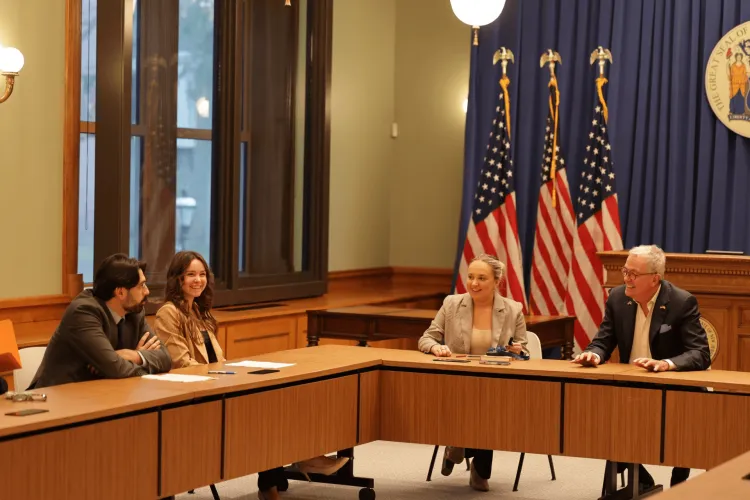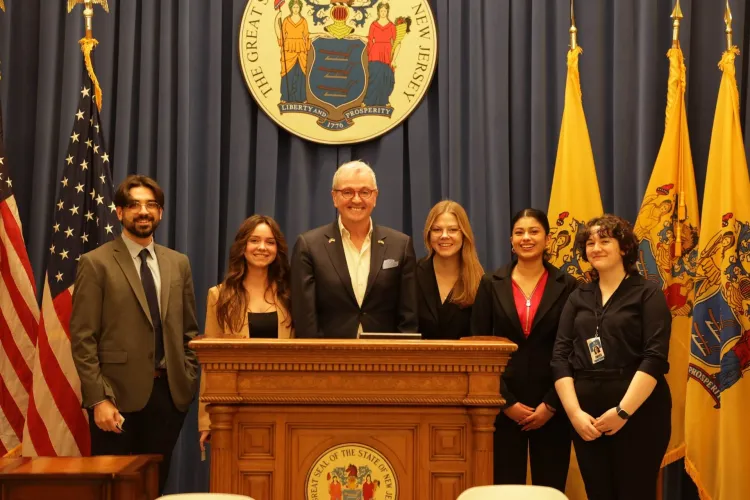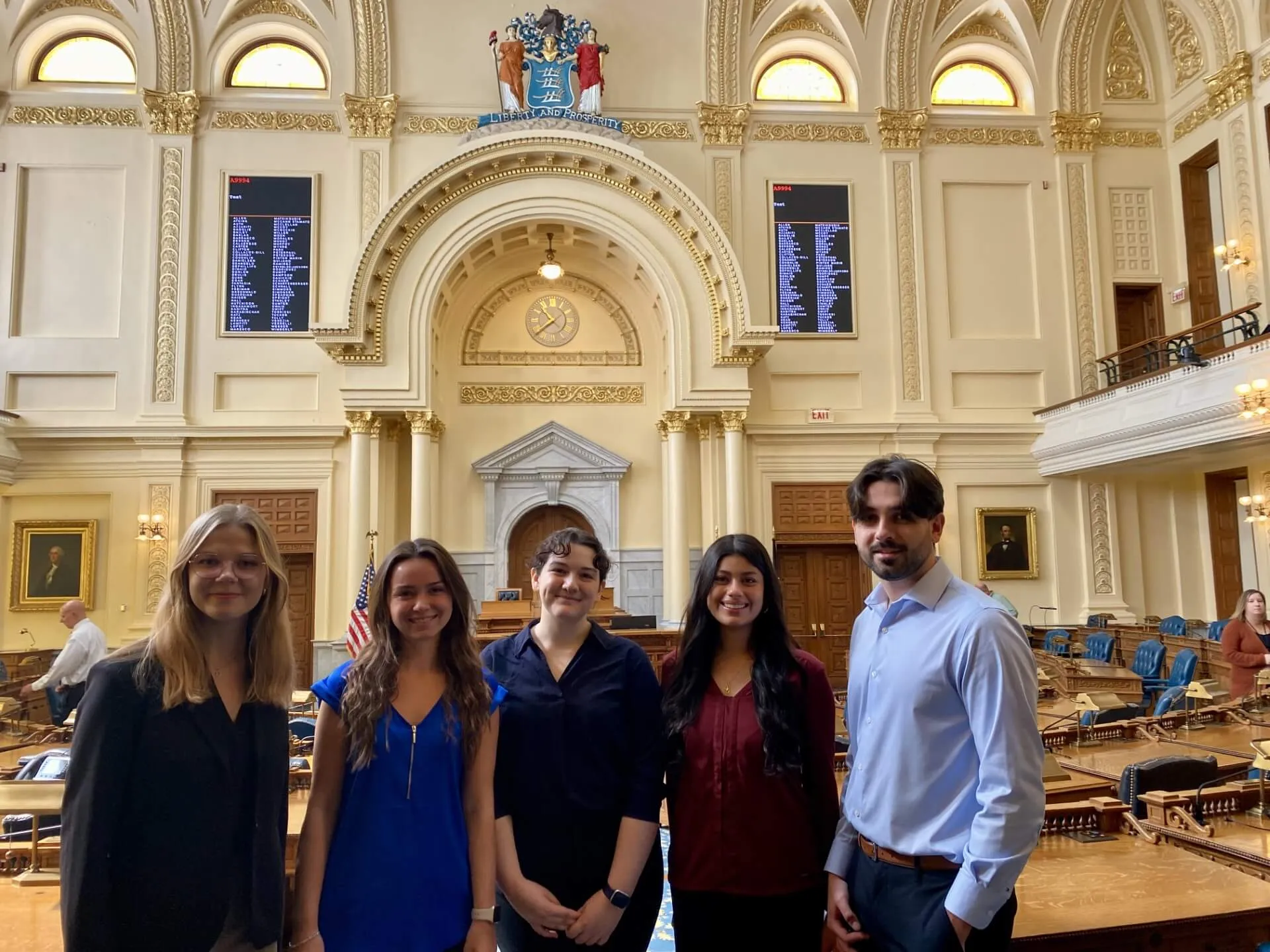Launched in the summer of 2023, the New Jersey Statehouse News Service is a collaborative nonprofit involving Rutgers University, Rowan University and The College of New Jersey, with potential future involvement from other universities.
The five-year plan aims to increase intern numbers from the current five to 10-12 per semester, with additional recent graduate fellows working 10 months at a time and a professional staff of three: a managing editor, a director, and a multimedia editor. (Currently, they have two part-time professional editors and five interns.) There’s no age or major requirement, but typically the students are juniors and seniors (usually, they prefer seniors) with a journalism background.
The service currently partners with 22 organizations comprising more than 100 news outlets. Howlett is exploring new sustainable funding sources, such as through Report for America, and wider media partnerships to cover more of the 400-plus media outlets in New Jersey. The program offers interns class credit and mileage reimbursements, and are otherwise unpaid; in the future, Howlett also wants to give students stipends of around $2,500. The State House News Service is entirely a wire service and, as of now, doesn’t publish anything themselves. They are starting with $100,000 in funding from the New Jersey Civic Information Consortium; this money has been used to hire additional part-time staff.
As of February 2025, Howlett has set up a trial internship program for their summer session funded by Princeton University. Princeton will pay for and coordinate the students, who will come to the statehouse and work for the NJ State House News Service. This will help the program cover the legislature into the summer when students who work during school semesters are done.
“The time between the middle of May and the end of June is really probably the busiest time of the session,” she said. “And we haven't had a lot of students because they're out of school by then. So that is that six-week period is where the Princeton students are going to fill in.”
Howlett is considering paying one of the current spring interns to also stay for an extra six weeks and do the same thing, budget permitting.
The amount of hours students work for the program varies by the school they attend. They’re all asked to write one to two stories per week: a straight news story and a more ambitious enterprise story. The program is not strict about meeting a quota.

About 20 years ago, New Jersey boasted more than 70 full-time statehouse reporters across media: print, radio, TV, etc. Now, there are fewer than two dozen full-time statehouse reporters. Often, among those two dozen, there are specific beat reporters such as with Spotlight New Jersey, e.g. the environment, education, or health coverage. When Howlett worked at the Star-Ledger, the statehouse bureau had 12 reporters and two editors. Now, it’s one editor and three reporters.
The College of New Jersey is about five miles away from the capital and is the closest of the three schools participating. The other two schools are about 40 miles – a one-hour drive – away.
No faculty members besides Howlett are working on this program.
In order to raise awareness about the State House New Service, Howlett has created stickers that students can put on their laptops as well as business cards with the same logos. The business cards are blank on the back so students can write their contact information on the back. Students also get press credentials for when they are at the capitol.
Like professionals, students often don’t get calls back from the officials and politicos they’re looking for comment from. Howlett said it’s a good opportunity for students to go to the committee hearings and government meetings to pigeonhole them in person.
“ I say it's important for you to actually be in Trenton, even though it's sort of a pain,” she said. And if you're only here for two hours, it seems like you spend more time driving to and from than actually here. But it's important to be here because that face time, that personal interaction, is what actually gets you stories. And at first, I think they're sort of skeptical, but by the end of the semester, they're all like, ‘Oh yeah, it's totally true.’”
“In addition to producing content, it teaches them how to be journalists, which I think is critical,” she added.
Her advice to other faculty looking to emulate her program: Don’t wait to be fully funded.
“I sort of looked at our first semester as a beta test, just to see what we could do,” she said. “And that actually helped us when we went to apply for funding because our funders looked at it and went, ‘Oh yeah, you're actually doing this stuff, so we'll invest in you.’ If we hadn't done that, I think they would have been much more skeptical and much more leery of actually supporting the work that we do.”
She continued: “I think just actually getting something rolling is really critical. However you can do it, whether it's just with a couple of interns and you doing 10 stories a semester each, whatever that takes, whatever that looks like for you, I think that's the important part.”

Howlett was a New Jersey statehouse reporter for eight years and knows many of the people still working there. Because of her reputation, she also has a lot of respect for the journalism she did, so people at the statehouse as a result are more likely to trust the validity of her budding program. Howlett was at USA Today for 17 years in total, including as a national reporter covering political campaigns. Howlett’s managing editor is also a former statehouse reporter, which she said has been helpful because she is familiar with the current administration.
The New Jersey statehouse’s press row has been replaced with a press room with 10 desks for reporters to share. While they have WiFi and outlets, there’s no privacy and it’s hard to make a phone call with all the noise from others talking.
Howlett received a $1,000 faculty champion grant from the Center for Community News to pay for her to go to Missouri, then was hired part-time as a contractor for CCN which allowed her to have some income.
